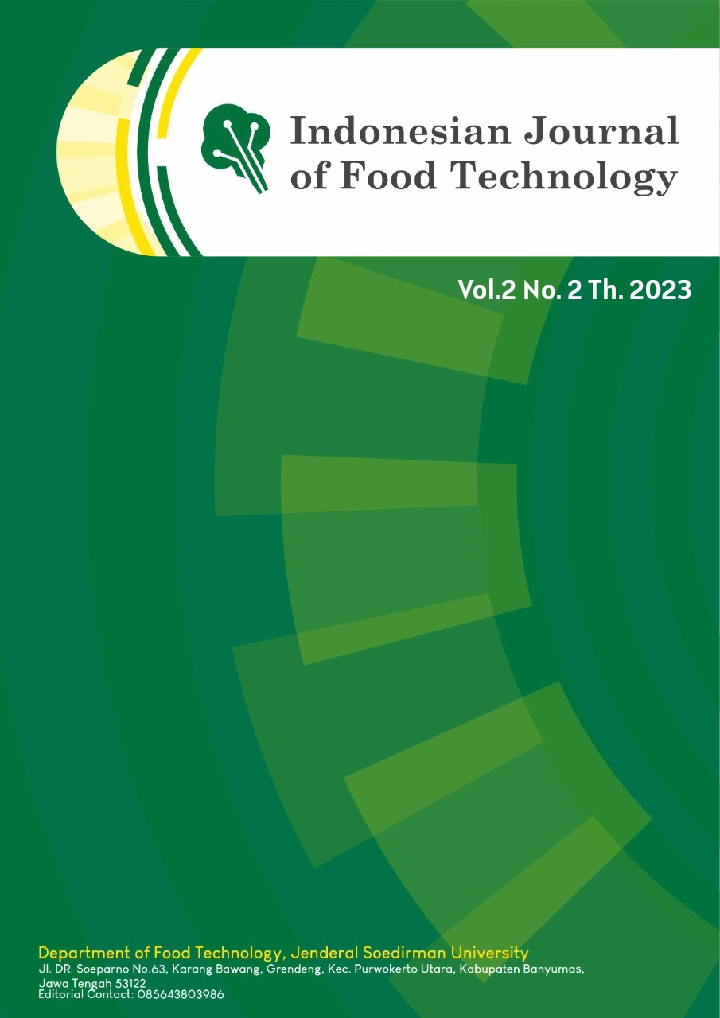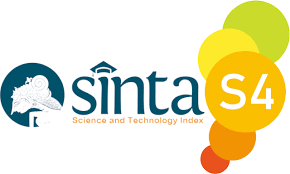Use of Banana Peel as a Raw Material for Banana Peel Nugget on a Small Industrial Scale
Abstract
The aim of this research is to obtain the best treatment from the use of various types of banana peels with flour and sago formulations in making banana peel nuggets and to find out the business feasibility analysis of making banana peel nuggets resulting from the best treatment. This research was designed using a Randomized Block Design (RAK) with two factors, namely the type of banana peel and the concentration of wheat flour and sago flour. Factor I: type of banana peel: 50% mas banana, 50% Ambon banana, 50% king banana, 50% milk banana, and 50% kepok banana. Factor II: concentration of wheat flour and sago flour: wheat (40%, 30%) and sago (10% and 20%). The parameters observed in this research were crude fiber content, water content, and liking test (aroma, color and texture). Statistical analysis was carried out using Analysis of variance ANOVA. Based on the research results, the addition of flour and sago concentrations did not have a significant effect on the fiber content, water content and organoleptic content of banana peel nuggets. The type of banana peel and the concentration of wheat and sago received the best treatment with Yield Value (NH), namely in the P5T1 treatment with 50% kepok banana peel treatment with 40% wheat flour and 10% sago flour with a value of 0.76. Banana peel nuggets contain 3.18% fiber content, 43.50% water content, 4.48% aroma preference, 4.35% color preference and 4.53% texture preference. The results of the business feasibility analysis obtained a Ratio (R/C) value of 1.55, so it was stated that the production of banana peel nuggets was feasible.
References
Astawan, M. 2003. Tetap Sehat dengan Produk Makanan Olahan. PT. Tiga Serangkai Pustaka Mandiri. Solo.
Badan Standardisasi Nasional. 2002. Standardisasi Nasional Indonesia. SNI 01- 6683-2002. Nugget Ayam (Chicken nugget). Badan Standardisasi Nasional. Jakata.
De Langhe E., Vrydaghs L., de Marret P., Perrier X. and Denham T., 2009. Why Banans Matter: An introduction to the history of banana domestication. Ethnobotany research and application. 7: 1547
Gomez, K.A. dan A.A. Gomez, 1995. Prosedur Statistik untuk Penelitian Pertanian. Diterjemahkan oleh: E. Sjamsuddin dan J.S. Baharsjah. UIPress, Jakarta.
Ismanto, H. 2015. Pengolahan Tanpa Limbah Tanaman Pisang. Laboratorium Pengolahan Hasil Pertanian. Balai Besar Pelatihan Pertanian Batangkaluku.
SNI 7758:2013. Persyaratan Mutu dan Keamanan Nugget Ikan. Dewan Standarisasi Nasional, Jakarta.
Susanti, Lina. 2006. Perbedaan Penggunaan Jenis Kulit Pisang Terhadap Kualitas Nata Dengan Membandingkan Kulit Pisang Raja Nangka, Ambon Kuning Dan Kepok Putih Sebagai Bahan Baku. Tugas Akhir. Semarang: UNNES.
Wilandika Leviana dan Vita Paramita. 2017. Pengaruh suhu terhadap kadar air dan aktivitas air dalam bahan pada kunyit ( curcuma longa ) dengan alat pengering electrical oven. Jurnal metana. Vol 13(2). Desember. Hal 37-44.
Winarno, FG. 2002. Kimia Pangan dan Gizi. Gramedia. Jakarta.
Winarno, F. G., & S. Koswara. 2002. Telur: Komposisi, Penanganan dan Pengolahannya. M-Brio Press, Bogor.











